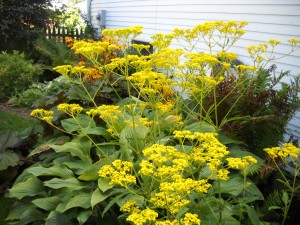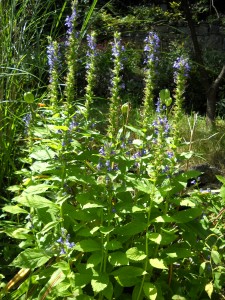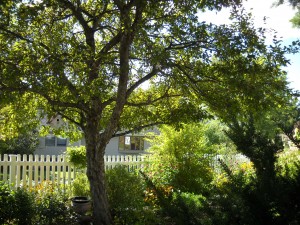How Long Does it Take to Create a Mature Garden?
Several years ago I interviewed the late Tasha Tudor, the reclusive illustrator and author, at her garden in southern Vermont. One question I asked her was, “How long does it take to create a garden?” Her answer, as reported in my book Organic Gardening (not just) in the Northeast, was succinct. “It takes twelve years to make a garden. Everything takes time that’s worthwhile.” I find that fascinating in light of recent visits to the gardens of Susan Weeks, of Lebanon, NH. Her lovely mature gardens were started around the year 2000 – some 12 years ago. And although Susan says they are still a work in progress, hers would make most gardeners ready to sit back and just admire them.
Susan moved into her house in 1995 with the idea that it was her final move: “I knew this was going to be my last home – the canvas I was going to be working on for the next 40 years – or until they drag me out of here.” When she moved in, her landscape consisted of a modern white house on a green lawn with just a few trees – a small blue spruce, a white pine and a rug of juniper on either side of the front door. It took her awhile to decide what to do, but by 2002 she decided to start planting some trees.
Susan decided to spend her money on trees that were already of fair size – at least 2 inches in caliper (diameter). She knew that she could cut corners and buy from a big box store, but doesn’t think it makes sense to do so. “I believe in buying local. They (locals) know what works here. It might be more expensive, but it works out better for everyone,” she told me. Over a few years she had a crab apple, two sugar maples, a Japanese tree lilac and a Japanese red maple installed. She kept them watered, made sure the lawnmower stayed away, and now these trees provide shade and beauty.
A mature woman of relatively small stature, Susan knew that these trees would best be installed by someone else, so she hired E.C. Brown Nursery of Thetford, Vermont to supply the trees and plant them. “As you get older, if you have some heavy work that needs to be done, it makes sense to get somebody it to do it for you.” That allowed her to work on the perennial gardens that she has developed over the past 10 years.
Gardening should be fun, and should be consistent with a gardener’s value system. Susan has two adorable old dogs that have grown up in her gardens, and she decided from day one that no chemicals would be used in her gardens – she didn’t want to risk harming Zoe and Maggie, her dogs. She fenced in part of the yard so the dogs would have a nice place to lounge around, and trained them to respect the flower beds while allowing them places to dig holes to lie in on hot days. Over the years she has expanded the fencing 3 times (as her budget allowed, I suppose) and the 4-foot tall white picket fence now encloses just about all of her property. There is a buffer zone, also planted, between the fence and the street.
Susan started planting perennials, adding the more each year. She has plenty of common flowers: bee balm, hostas, daylilies, iris, and black-eyed Susans. But after awhile, she took a four-evening class on gardening and started to get more confidence. She craved more interesting and unusual plants.
She tried Canadian burnet (Sanguisorba canadensis), great blue lobelia and ligularia. She got things with no common name like Persicaria superbum. Right now she has a tall shade-loving plant with bright yellow flowers that I’d never seen before, one she got from Cider Hill Gardens in Windsor, Vermont. It’s a Patrinia (no common name) and it’s not clear if it is a P. triloba or a P. gibbosa. I must get one.
At some point Susan decided she needed a small water feature, and created a little pond about 8 feet long and 3 to 4 feet wide with a pump that shoots a gentle stream of water into the air. She dug the hole herself, lined it with a special rubber liner, and covered the edges with flat stones. “A weekend project,” she said. She put in goldfish – and moved them indoors each winter to keep them alive. She told me that the sound of the bubbler is good for attracting birds. She loves the birds – another good reason for using all organic products.
Over time Susan has introduced flowering shrubs to her landscape, saying that as one gets older it’s important to have lower-maintenance plants. She is moving away from perennials that need to be dug and divided on a regular basis. Among the shrubs she has planted are weigela, hydrangeas, lilacs, ninebark, fothergilla; blueberry (for fall foliage); beauty bush; viburnum, daphne, Clethra, butterfly bush and others. She has a dog-eared copy of Taylor’s Guide to Shrubs, and each time she plants a new shrub she ticks it off in the book and writes the date planted.
And although Susan says she is cutting back, slowing down, I noticed that she had just excavated a new bed outside her fence. And she is eyeing a bit of lawn by the street. “Grass – it’s just one big perennial. It’s okay to dig some up for other perennials.” I can’t wait to see what happens in her gardens after she retires from her job in a few years.
Henry Homeyer’s upcoming kid’s book, Wobar and the Quest for the Magic Calumet, will be on shelves in October.






